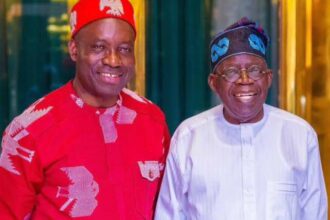Nigeria’s total public debt has risen to an all-time high of ₦152.40 trillion as of June 30, 2025, according to new data released on Saturday by the Debt Management Office (DMO). The figure, which includes the combined domestic and external debt of the federal and state governments, represents an increase of ₦3.01 trillion or 2.01% within just three months.
In dollar terms, the nation’s debt grew from $97.24 billion in March 2025 to $99.66 billion by June, reflecting a 2.49% increase, underscoring the country’s persistent reliance on borrowing to bridge fiscal gaps amid revenue shortfalls and exchange rate pressures.
The DMO attributed the debt rise to a combination of new domestic bond issuances, external disbursements from multilateral and bilateral lenders, and exchange rate adjustments following Nigeria’s foreign exchange liberalisation policy introduced earlier in the year.
“The increase in total public debt stock was due to additional borrowing to fund budgetary deficits and project financing by the federal and state governments,” the DMO statement read. “While revenue reforms continue, borrowing remains essential to finance infrastructure, social investments, and other critical expenditures.”
Breakdown of External Debt
A closer look at the data reveals that Nigeria’s external debt rose from $45.98 billion in March to $46.98 billion (₦71.85 trillion) in June. This represents nearly 47% of the country’s total public debt.
The World Bank remains Nigeria’s single largest external creditor, accounting for $18.04 billion, or 38% of the nation’s total external debt. Most of these obligations are concessional loans from the International Development Association (IDA), which offer lower interest rates and longer repayment periods.
In total, multilateral lenders — including the World Bank, African Development Bank (AfDB), International Monetary Fund (IMF), and Islamic Development Bank (IsDB) — collectively hold $23.19 billion, representing 49.4% of Nigeria’s external obligations.
Bilateral loans, obtained through agreements with individual countries, stood at $6.20 billion. Among these, China’s Exim Bank remains the largest bilateral lender with $4.91 billion, followed by France, Japan, India, and Germany.
The report also shows that commercial loans, particularly Eurobonds, accounted for $17.32 billion, or 36.9% of Nigeria’s external debt portfolio. A smaller portion — $268.9 million — came from syndicated loans and direct borrowings from international commercial banks.
Economic analysts have expressed concern over the nation’s growing Eurobond exposure, warning that it exposes Nigeria to the volatility of global financial markets, especially in times of rising interest rates and dollar appreciation.
“Nigeria’s heavy dependence on Eurobonds increases refinancing risk,” said Dr. Tunde Afolabi, a Lagos-based financial analyst. “Given the global interest rate environment, debt servicing costs could rise sharply, putting further pressure on the naira and government revenues.”
Domestic Debt Also on the Rise
On the domestic front, total debt climbed from ₦78.76 trillion in March to ₦80.55 trillion in June, an increase of ₦1.79 trillion or 2.27%. The Federal Government of Nigeria (FGN) remains the dominant borrower in the domestic market, accounting for over 90% of local debt instruments.
FGN bonds remain the backbone of domestic borrowing, amounting to ₦60.65 trillion, or 79.2% of the total domestic debt. This figure comprises:
-
₦36.52 trillion in naira-denominated bonds,
-
₦22.72 trillion in securitised Ways and Means advances from the Central Bank of Nigeria (CBN), and
-
₦1.40 trillion in dollar-denominated bonds issued locally.
Other domestic debt instruments include Treasury Bills (₦12.76 trillion), Sukuk bonds (₦1.29 trillion), Savings Bonds (₦91.53 billion), Green Bonds (₦62.36 billion), and Promissory Notes (₦1.73 trillion).
The inclusion of securitised CBN Ways and Means advances — funds previously borrowed by the Federal Government from the central bank — continues to stir debate among economists. Critics argue that excessive dependence on this facility has fuelled inflation and increased Nigeria’s fiscal vulnerability.
Debt Sustainability and Fiscal Concerns
Despite the mounting figures, the DMO maintains that Nigeria’s debt remains “within sustainable thresholds” compared to the country’s Gross Domestic Product (GDP). However, experts warn that the real challenge lies not in the size of the debt but in the cost of servicing it relative to revenue.
According to the 2024 Medium-Term Expenditure Framework (MTEF), Nigeria currently spends over 70% of its revenue on debt servicing, a ratio many economists describe as unsustainable.
“The danger is not in the debt stock itself but in the weak revenue performance,” said Professor Ngozi Anigbo, a fiscal policy expert at the University of Nigeria. “Until Nigeria significantly expands its non-oil revenue base, every additional borrowing will tighten the fiscal space.”
The federal government has repeatedly defended its borrowing strategy, arguing that loans are being directed toward productive sectors, including infrastructure, energy, agriculture, and human capital development. However, with declining oil output and persistent subsidy payments, critics insist that much of the borrowing is being used for recurrent expenditure rather than capital investment.
Debt Composition and Exchange Rate Impact
The DMO’s latest report also highlights the impact of exchange rate depreciation on the debt profile. Since the unification of Nigeria’s multiple exchange rates in early 2024, the naira has lost significant value against the U.S. dollar, inflating the local currency value of external obligations.
The office acknowledged that while external borrowings are largely concessional, the depreciation of the naira has led to higher naira-denominated debt totals, even without new loans being taken.
“Exchange rate movements contributed to the nominal increase in the naira value of external debt,” the DMO noted.
Analysts fear that this could complicate debt sustainability metrics and further strain the country’s already limited fiscal space.
Regional and State-Level Debts
The DMO’s data also captures sub-national debt, showing that Nigeria’s 36 states and the Federal Capital Territory (FCT) collectively owe ₦8.45 trillion, up from ₦8.32 trillion in March. The states’ debts consist mostly of domestic borrowings from commercial banks and capital market instruments, as well as external loans obtained through federal guarantees.
The Road Ahead
With total public debt now at ₦152.4 trillion, economists say Nigeria faces an urgent need for comprehensive fiscal reform and revenue diversification. The federal government has initiated several measures, including the National Tax Reform Committee, the removal of fuel subsidies, and efforts to boost non-oil exports, but results remain modest.
The DMO continues to urge prudent debt management, transparency, and prioritisation of concessional funding sources to reduce the country’s exposure to market-based loans.
As Nigeria approaches another budget cycle, the challenge before policymakers is clear: finding a balance between financing growth and maintaining fiscal stability. Without substantial improvements in revenue generation, the cycle of borrowing may deepen — with lasting implications for future generations.





